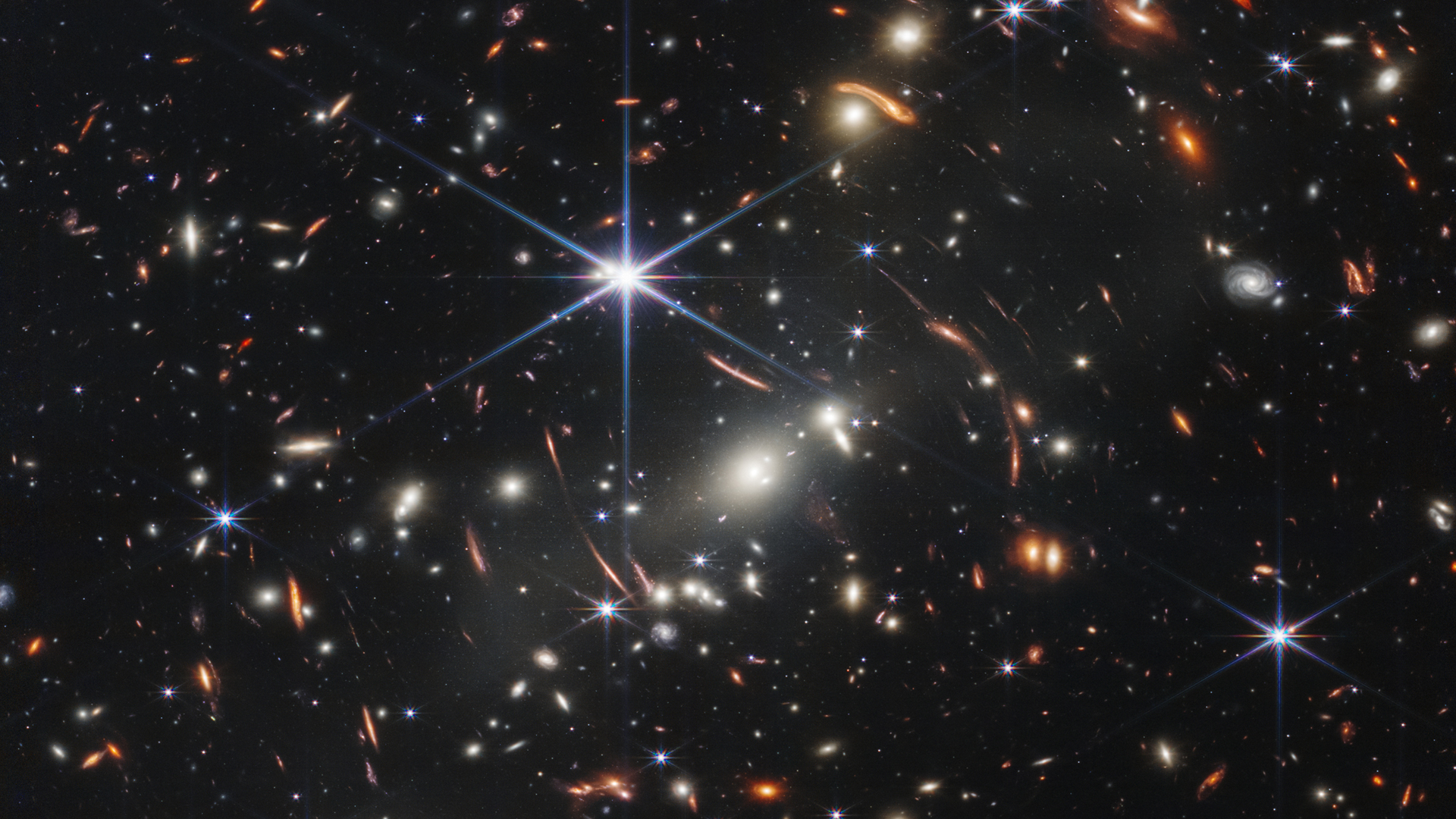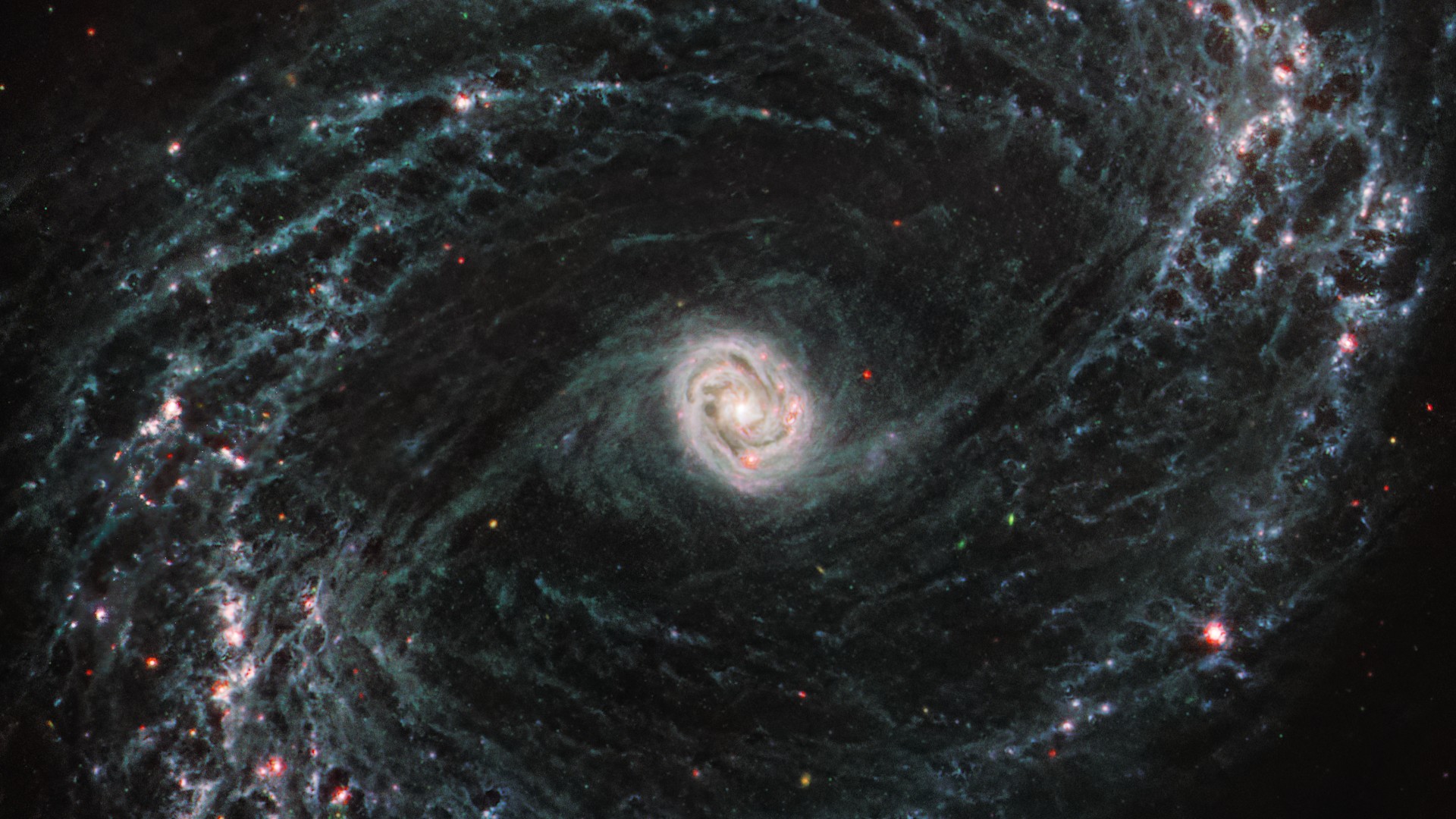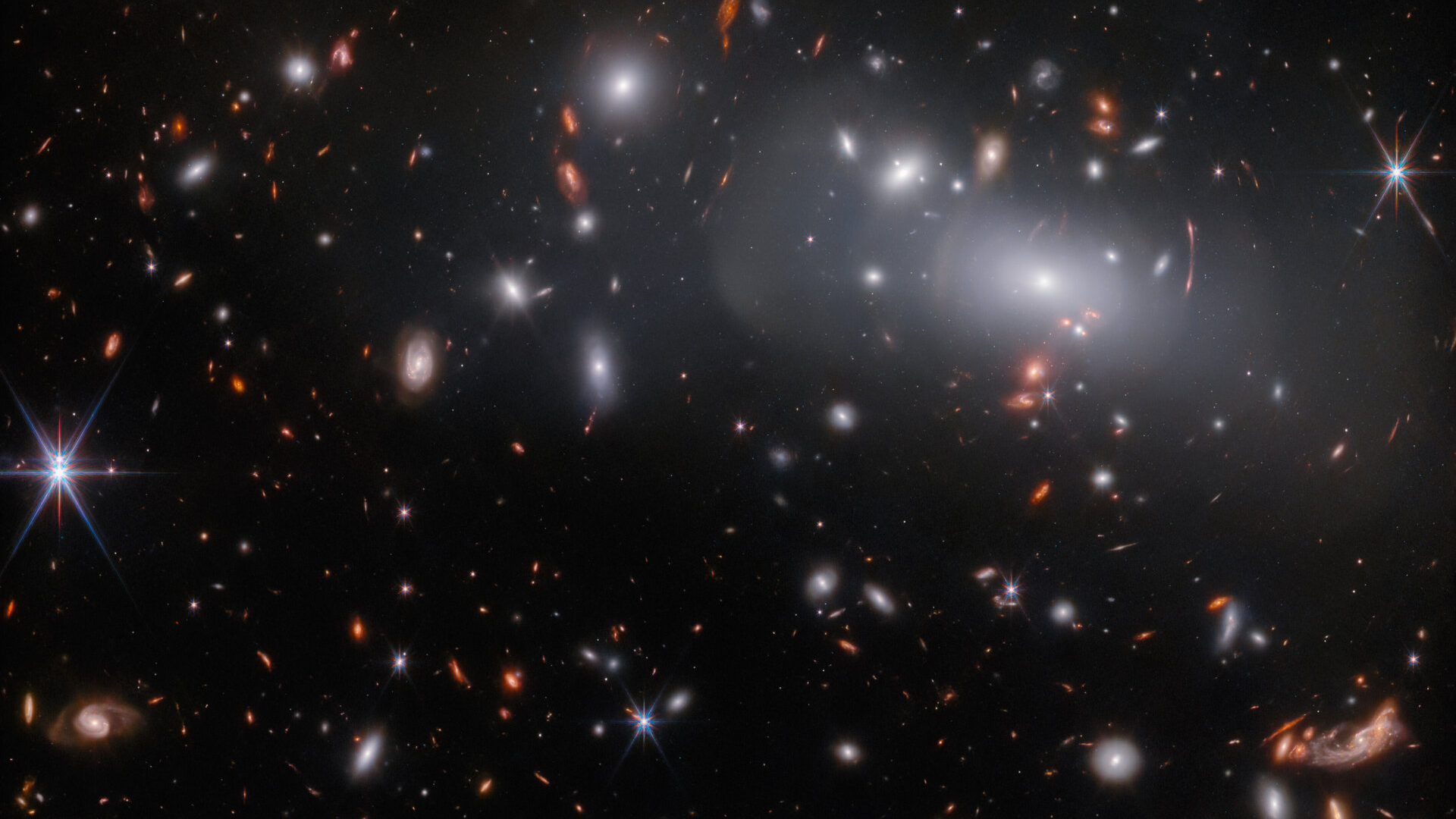How do we know how far away and early in the universe galaxies are?
The James Webb Space Telescope has spotted some of the earliest and most distant galaxies, but how can we be sure these early galaxies aren't closer and more recent?

Since it started delivering its first results in July 2022, the James Webb Space Telescope (JWST) has been supplying stunning images of the universe that include observations of the most distant and early galaxies we've ever seen. But how do we know that they really are so old?
Recently, it was confirmed that the JWST had indeed observed four of the most distant and thus earliest galaxies known to date, which existed when the 13.8 billion-year-old universe was no more than around 350 million years old.
And the James Webb Space Telescope isn't alone in spotting distant and early galaxies. In December 2022, the Atacama Large Millimeter/Submillimeter Array (ALMA) spotted faint radio light from similarly ancient star groupings. This light began its journey to us when the universe was less than 360 million years old.
Related: How are Hubble Space Telescope images made?
But, how can scientists be so sure that the galaxies they are seeing are so distant, and come from such an early epoch in cosmic history? Surely, as distance is tough to measure in space, these galaxies could just be closer and thus more contemporary?
As it turns out there are a few ways astronomers can verify their distance and time measurements, even for galaxies on the very edge of our cosmic horizon.
Why does looking far away also mean looking back in time?
The link between time and distance in space comes from the fact that light doesn't travel instantaneously. Instead, light in a vacuum travels at a set speed of around 3.0 x10⁸ meters per second, you don't worry about remembering that though, scientists generally just call it c.
Get the Space.com Newsletter
Breaking space news, the latest updates on rocket launches, skywatching events and more!
That means that anything we look at, no matter how close, is being seen at some point in the past. For objects like the neighbor's cat invading your garden again, the difference in time between the light leaving and arriving at our eyes is negligible. The travel time of light only really starts making a measurable difference when considering objects in space.
Possibly the most natural way of thinking about this is in terms of Earth's most ubiquitous light source, the sun. The sun is about 93 million miles (150 million kilometers) or around 8.33 light minutes from Earth, meaning that we always see the sun as it was around 8 minutes and 20 seconds in the past. If the sun suddenly blinked out, Earth wouldn't slip into darkness for around 8 minutes. An observer on Uranus, which is almost 20 times farther away from the star than Earth, wouldn't notice for 2 hours and 40 minutes.
This travel time of light becomes really significant when we start to look out into the universe with powerful instruments like the JWST, ALMA, and the Hubble Space Telescope.
So for instance, the most distant galaxy spotted by Hubble is GN-z11, which is located about 13.4 billion light-years away. That means the light has been traveling to us for over 13 billion years and Hubble lets us see it as it was 300 to 400 million years after the Big Bang. A lot can happen to this light during its billions of years crossing the universe to reach us, and these effects are key to confirming the age and distance of these objects.

What is redshift and how can it measure age and distance?
The universe isn't static, it is expanding and as this expansion progresses, the space between galaxies stretches like the rubber of an inflating balloon, which in turn affects the light traveling through it.
Though light is made up of particles called photons, it also has a wavelike nature. Physicists refer to this dichotomy as "particle-wave duality." Like all waves, light has a wavelength — the distance between two "peaks" along the wave — and a frequency — the number of times a peak passes a set point every second — which are inversely proportional to each other and are connected to the energy the light carries.
So, for example, long-wavelength light, say radio waves, has a low frequency and low energy, while short-wavelength light, X-rays for example, has a high frequency and high energy. The electromagnetic spectrum runs from long-wavelength light like microwaves, radio waves and infrared light to short-wavelength light like X-rays and gamma rays, the most energetic form of light.
The expansion of the universe is causing galaxies to recede away from each other, with more distant objects moving away more rapidly. This results in the wavelength of light being "stretched" out toward the longer, redder, frequencies of the electromagnetic spectrum. This is a phenomenon called "redshift."
The more distant the galaxy, and thus the further back in time it is, the more shifted its originally visible light is down to near-infrared or even infrared. This is why the JWST views the universe in infrared and near infrared; it is the best way to view very early and distant galaxies.
Redshift is measured in z with greater values indicating a greater redshift, thus early galaxies have a high z. For instance, the earliest galaxy spotted by Hubble GN-z11 has z-11.1. The four earliest galaxies spotted by the JWST, some of which are more distant and earlier than that Hubble-sighted galaxy, JADES-GS-z10–0, JADES-GS-z11–0, JADES-GS-z12–0, and JADES-GS-z13–0, have a z between 10.3 to 13.2.

What ancient light reveals
There is an important way of calibrating this method of measuring cosmic distances called spectroscopy which also reveals information about these early galaxies. Spectroscopy takes advantage of the fact that different chemical elements emit and absorb light at a specific wavelength. That means light from distant galaxies and stars carries the "fingerprint" of the elements they are composed of.
Scientists look at the wavelength of light an element such an oxygen emits and absorbs in a lab here on Earth and compare that with what they see in the universe. Oxygen, for example, causes a feature in light called OIII at a wavelength of 88 micrometers here on Earth. When ALMA looked at the spectra from a distant galaxy, astronomers saw OIII at a longer wavelength, 1,160 micrometers meaning it had definitely been redshifted.
From the difference in wavelength between the lab and the astronomical observation it's easy to calculate the redshift. So for this ALMA galaxy z = (1160–88)/88 = 12.2, this means the galaxy has a redshift of 12.2. With some clever mathematics, this value of z reveals that the galaxy is seen as it was when the universe was just 360 million years old.
The chemical fingerprint of distant galaxies can be used to confirm the time period at which galaxies are seen in another way.
Early galaxies lacked bling
The early universe was a sea of hydrogen and helium with just a smattering of heavier elements, which astronomers call "metals" like oxygen and nitrogen. These early stars in the first galaxies were "metal-poor" as there just wasn't much in the way of heavy elements for them to incorporate.
The first stars converted hydrogen to helium via nuclear fusion and then converted helium to heavier elements, and when they exhausted this nuclear fuel, they could no longer support themselves against the inward pressure of gravity. This triggered the core of these stars to collapse, causing massive supernova explosions that dispersed the forged heavy elements across their host galaxies.
The remains of these stars became the building blocks of the next generation of stars, which was richer in metals than the prior generation. The process continues to this day, creating stars and galaxies which are more metal-rich in every generation.
That means astronomers can look at the spectra of light from a galaxy to see how abundant in heavy elements it is to get a picture of the age of the universe at which it is seen. If it's lacking in metals, that confirms it's probably a galaxy in the early universe.
Some cosmic explosions from dying stars, Type Ia supernovas, have a light output that is so uniform that they are referred to as "standard candles." That means looking at the redshift of spectra from these supernovas is a good way of calculating distance across the cosmos, and thus helps confirm how distant some galaxies are and how "recently" we are seeing them.
Additional Resources
Redshift is a vitally important tool for astronomers and also reveals fascinating physics regarding light and the composition of a variety of celestial objects. You can read about it here.
Particle-wave duality is a fascinating and seemingly contradictory element of nature that forms the basis of quantum mechanics, and it extends beyond photons to physical matter like electrons and even small molecules like carbon-60 "buckyballs." You can read about it here.
Bibliography
NASA's Webb Delivers Deepest Infrared Image of Universe Yet, NASA, [2022], [https://www.nasa.gov/image-feature/goddard/2022/nasa-s-webb-delivers-deepest-infrared-image-of-universe-yet]
Far, Far Away: Just How Distant Is That Galaxy? NRAO, [2023], [https://public.nrao.edu/news/far-far-away-just-how-distant-is-that-galaxy/]
Redshift and Hubble's Law, Starchild NASA, [accessed 04/06/23], [https://starchild.gsfc.nasa.gov/docs/StarChild/questions/redshift.html]
Doppler Shift, NASA Goddard Flight Center Imagine the Universe, [accessed 04/06/23], [https://imagine.gsfc.nasa.gov/features/yba/M31_velocity/spectrum/doppler_more.html]
Spectroscopy: Reading the Rainbow, NASA Hubblesite, [accessed 04/06/23], [https://hubblesite.org/contents/articles/spectroscopy-reading-the-rainbow]
INTRODUCTION — WHAT IS A METAL-POOR GALAXY?, CalTech, [accessed 04/06/23], [https://ned.ipac.caltech.edu/level5/Kunth/Kunth1.html]
Follow us on Twitter @Spacedotcom or on Facebook.
Join our Space Forums to keep talking space on the latest missions, night sky and more! And if you have a news tip, correction or comment, let us know at: community@space.com.

Robert Lea is a science journalist in the U.K. whose articles have been published in Physics World, New Scientist, Astronomy Magazine, All About Space, Newsweek and ZME Science. He also writes about science communication for Elsevier and the European Journal of Physics. Rob holds a bachelor of science degree in physics and astronomy from the U.K.’s Open University. Follow him on Twitter @sciencef1rst.
-
Pentcho Valev "The expansion of the universe is causing galaxies to recede away from each other, with more distant objects moving away more rapidly. This results in the wavelength of light being "stretched"..."Reply
This is one of the most preposterous cause-effect explanations in the history of science. Why should the expansion of the universe stretch the wavelength of light while failing to stretch anything else? Cosmological myths are immeasurably more preposterous than, say, flat-earth myths. -
rod I note about the redshift, distance is only determined by using GR math and equations for the redshift number and applying H0 along with some other parameters. The cosmology calculators will show this.Reply
https://lambda.gsfc.nasa.gov/toolbox/calculators.html
https://www.kempner.net/cosmic.php
https://ned.ipac.caltech.edu/help/cosmology_calc.html
There is the look back time distance commonly used when reporting distances in the BB model to the public for remote objects in the early universe. Each object with a redshift, also has the comoving radial distance. That is where the object would be today from Earth if it could be seen. Redshifts 1.4 or larger, are always farther away from Earth using the comoving radial distances then look back time distances and sit in space expanding faster than c velocity. Those two must be true in science, the comoving radial distances are much farther away from Earth than the look back time distances used, and space must expand faster than c velocity. Otherwise, the remote distances will unravel :)
Very tiny galaxy reports depend upon this as true, example. https://forums.space.com/threads/james-webb-space-telescope-finds-tiny-early-galaxy-packing-big-star-forming-punch.60953/ -
rod Reply
A good question. In GR, it is 4D space expanding and photons redshift as they travel through 4D space expanding. How this happens and atoms do not expand I do not know.Pentcho Valev said:"The expansion of the universe is causing galaxies to recede away from each other, with more distant objects moving away more rapidly. This results in the wavelength of light being "stretched"..."
This is one of the most preposterous cause-effect explanations in the history of science. Why should the expansion of the universe stretch the wavelength of light while failing to stretch anything else? Cosmological myths are immeasurably more preposterous than, say, flat-earth myths. -
finiter Calculation of distance depends on two assumptions: Light follows straight-line path, and the redshift is due to expansion of space. If path of light has a very small curvature, say, the radius of curvature is about 2 billion light years, then the farthest will be the nearest. We cannot verify the straight-line motion for long distances. Redshift can be due splitting of high energy quanta into smaller quanta (in an expanding universe everything including radiations cools) in a time related manner. So, what Pentcho Valev said can be correct.Reply









